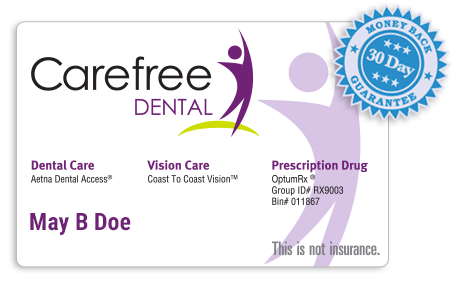How Much Do Dental X-Rays Cost Without Carefree Dental?
Because dental x-rays can be expensive, many people use either dental insurance or a dental discount service (like Carefree Dental) to help offset the cost of dental x-rays.
What if you don’t have one of these services? What would your full out-of-pocket cost be?
There’s no way to say for certain, because the cost of dental x-rays will vary depending on a couple different factors:
- The local market & demand
- Each provider’s price structure
- Which x-ray images are being taken
According to dentists on sharecare, you can expect to pay about $12-$25 for a single image. Your dentist will almost always take more than a single image, though, so expect to pay more than that.
The highest cost you would likely pay would be for a full-mouth series (also called panoramic x-rays), which would run you anywhere from $100-$200.
Most providers prefer to take x-rays on a regular basis, such as once a year, so they can monitor any changes in your oral health. For that reason, we recommend that you think of dental x-rays as a regular annual cost of $100-$200.
What’s the Best Dental Plan for X-Rays?
If you’re in the market for different dental x-ray payment plans, you have a few choices available:
- Pay out-of-pocket. This is the most expensive option, because you’ll have to pay the full cost yourself.
- Pay for dental insurance. For a monthly fee of $20-$50 or more per month, dental insurance will usually cover any preventive dental care like x-rays.
- Invest in a dental discount card. A dental discount card like Carefree Dental is the most convenient and affordable way to get affordable dental x-rays, while also avoiding the high monthly payments that often come with insurance.
When comparing these options, don’t focus entirely on the cost. Remember that each option requires a different amount of time and effort.
Paying out-of-pocket is the simplest method, since there’s no extra work required. However, in this scenario you also have to foot the entire bill yourself.
Paying for dental insurance is by far the most difficult, time-consuming, and complicated payment plan for dental x-rays. You’ll have to submit claims, fill out paperwork, check that the procedure is covered by your plan, and make sure that you aren’t going over your maximum benefit amount. (Most forms of dental insurance set an annual savings cap of around $1,500.)
Investing in a dental discount card like Carefree Dental might be the perfect compromise between those two solutions. It requires almost no time or effort: all you have to do is remember to bring the card to your appointment, and you’ll instantly save 15-50% per visit*, in most instances on your procedure. There are no annual savings caps, and one card works for your entire household if you are on the family plan.
We might be biased, but if you ask us, investing in a dental discount card sounds like the smart way to save money on your dental expenses.
Oh, and did we mention your card is activated as soon as you submit your payment? That means you can use your card on your next appointment, even if it’s later today.
How Much Does A Dental X-Ray Cost With Carefree Dental?
On average, the Carefree Dental Card will save you 49% on dental x-rays. That’s $85 every time you get a full-mouth series of 18 x-rays.
Remember, many providers recommend getting x-rays once per year. So that isn’t just a one-time savings of $85. It’s an annual savings of $85.
And don’t forget that you will have other costs associated with your x-rays. You’ll also have to pay separately for the cleaning and the oral exam.
Out-of-pocket, you’d pay an average of $380 for a single appointment that includes an exam, oral cleaning, and x-rays.
But with Carefree Dental, that cost would come down to just $193--saving you a cool 49%.
Get Access to Aetna Dental Access®
One of the best things about Carefree Dental is that it gives you a discount on a nationwide network of participating providers to choose from, along with the trust and familiarity of staying within the Aetna Dental Access® Network.
No matter where you live, there’s most likely to be a participating provider near you. There’s a good chance you’ll even be able to continue seeing the same dentist you’re already used to. (The only thing thing that would change would be that you will pay a lower rate.)
Click below to find out if your dentist accepts the Carefree Dental Card:
Why Are Dental X-Rays Important?
X-rays are an important tool in your dentist’s diagnostic arsenal. While your dentist can tell a lot about the health of your teeth and gums from an oral exam, there are certain things your provider simply can’t discern with the naked eye.
By having x-rays taken, your dentist will get a much clearer picture of how healthy your teeth are below the surface. X-rays can help dentists to make more accurate diagnoses, locate the source of oral pain, find cavities, look for signs of oral cancer, and more.
Many dentists like to take x-rays on your first visit to help establish a record of your oral health. After that, they will probably recommend that you have your x-rays taken again at regular intervals (every 6-12 months or longer, depending on the state of your teeth and gums).
Types of X-rays
There are many types of X-rays, or radiographs, and each has their specific use in aiding your dentist. Described below are some of the most commonly used X-rays by dentists today.
Bitewings
Bitewings are one of the most common types of X-rays, which show the teeth above the gum line and the bone height between the teeth. These help in diagnosing cavities between the teeth and gum disease. Bitewings are taken often for patients with frequent cavities.
Full Set
This type of X-ray is typically recommended during the first visit at a new dental office. The set is usually about 14-20 individual X-rays that show all of the teeth and surrounding bone. They are extremely useful in finding cavities, signs of oral cancer, and even gum disease.
Panorex
This type of X-ray is full-mouth like a full set, but it is only one large image. A panorex helps in finding impacted teeth and other hidden features that the small films in a full-set won’t show as easily. They are also useful for planning treatments for dentures, braces, implants and extractions.
Periapical
These X-rays are focused on a specific area of concern, such as a pain or toothache. Dentists often use periapicals to get a better understanding of your dental structure, and to give you a more accurate diagnosis.
3 Dimensional
This type of X-ray, also known as cone beam computed tomography, is the newest radiograph technology. Rotating X-ray equipment, combined with a digital computer, can capture clear pictures of the bone, muscle, soft tissue and blood vessels. They are often used if more basic imaging does not give dentists enough information for a confident diagnosis or treatment.
Frequency
The need for X-rays varies among different patients, their dental histories and current conditions. Most dentists ask new patients to get X-rays to establish a record with their office. Those with no recent cavities or gum disease may not need X-rays for several years, but others may want to get them as often as every six months. For children, however, there is more of a risk of tooth decay, and you may wish to have your children get X-rays frequently.
Carefree Dental Includes Vision & Prescription Benefits
Your new discount card with Carefree will also give you significant discounts on vision & prescription benefits included at no extra charge.
That means you’ll also save big on eye exams, glasses, and prescription medications from pharmacies like CVS and Walmart.
Coast to Coast Vision™
Save 10–60% on glasses, contacts, Lasik surgery, eye exams, and even designer eyewear.
OptumRx®
Save 10–85% at over 65,000 pharmacies including CVS, Rite Aid, and Walmart.
Sign Up Today, Save Today!
If you’re looking for affordable dental x-rays, let’s face the facts: there’s no point in paying more than you have to.
An x-ray is an x-ray, and expensive x-rays won’t be any more helpful to you or your provider than cheap x-rays will.
With a Carefree Dental Discount Card in your wallet, you’ll instantly save 15-50% per visit*, in most instances on all your dental expenses--even for procedures that insurance doesn’t cover.
There’s no contract, no paperwork, and no annual savings cap. In short, there’s no reason not to sign up for Carefree Dental and start saving money today.
Remember, after you sign up you’ll be eligible for both our 30-day money-back guarantee and the one-year savings guarantee. You’re guaranteed to save money with Carefree Dental, so what are you waiting for?
"I had 4 teeth extracted and received a full set of dentures. I saved around $5,000. I am recommending Carefree to others and very happy with the plan!"
30-Day Money-Back Guarantee
If you're not 100% happy with your plan, cancel within the first 30 days after the effective date and we'll refund you in full—no questions asked, no hassle.
Money Back Savings Guarantee
If the savings on your dental care for the year add up to less than your plan’s annual cost, the difference will be paid directly to you.
* Actual costs and savings vary by provider, service and geographical area.
**As of September 2021





